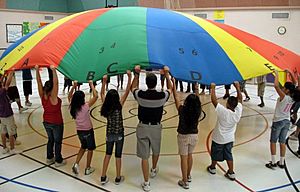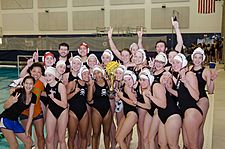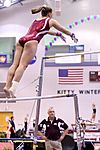Physical education facts for kids
Physical education, often called P.E. or Phys Ed, is a school subject taught worldwide. It helps you learn through play and movement. P.E. teaches you about health and how to stay fit. In P.E. class, you might play games like football, netball, hockey, rounders, cricket, four square, or have races. You also learn about healthy eating and good habits.

P.E. classes are different in schools around the world. When taught well, P.E. can make students healthier. It can also help with their behavior and even their school grades. Sometimes, P.E. is combined with health education. This means you learn about preventing and treating illnesses. This combined subject is sometimes called P.H.E.
Contents
How P.E. is Taught
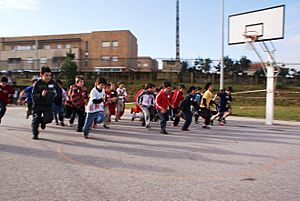
The main goals of modern physical education are:
- To show kids and teens many different exercises and healthy activities. P.E. is a great chance for almost all children to be active and healthy.
- To teach skills that help you stay fit and healthy throughout your life.
- To encourage you to track and report your own exercise.
- To help you find the best amount, effort, and type of activity for you.
- To focus on how well you work, not just the final score.
- To provide good examples of active people.
It's very important for P.E. teachers to help you improve your movement skills. They give you basic skills that build your ability to move. This helps you take part in many different games, sports, and activities as you grow up.
Teachers can reach these goals in many ways. Rules from your country, state, or local area often decide what must be taught. These rules set the topics, what teachers need to know, and what books or materials to use. This can include teaching sports, overall fitness, or movement that isn't part of a sport.
These teaching ideas come from early P.E. experts like Francois Delsarte and Rudolf von Laban. In the 1800s, they focused on how children could use their bodies to express themselves. Later, in the 1960s, ideas about body awareness and space were added. All these ideas led to how physical education is taught today.
When P.E. is taught well and in a positive way, it has many health benefits. These include a lower risk of certain health problems and a stronger heart. It can also improve your mental health. Studies also show that being active helps your brain develop.
P.E. can also help you do better in other school subjects. Researchers found in 2007 that students who had more P.E. classes scored much higher on English tests.
Using Technology in P.E.
Many P.E. classes use technology to help students exercise better. A simple video recorder is one popular and affordable tool. Students can record themselves doing activities like throwing or swinging. Then, they watch the video to see their mistakes. Studies show this helps them learn more than just being told what they are doing wrong.
Teachers might also use tools like pedometers and heart rate monitors. They can set goals for how many steps students take or what their heart rate should be.
Other technologies used in P.E. include video projectors and GPS systems. Gaming systems like the Kinect, Wii, and Wii Fit can also be used. Projectors show students the correct way to move or how to play games. GPS systems can get students active outdoors. Active "exergames" can show students fun ways to stay fit both in and out of class.
P.E. Around the World
The World Health Organization (WHO) suggests that young people should exercise for at least 60 minutes every day, at least 3 times a week. This helps them stay healthy.
Asia
Philippines
In the Philippines, P.E. is a required subject for all school years. Some schools even include martial arts training in their P.E. classes.
Singapore
In Singapore, students take a required fitness test called NAPFA every two years. This test checks how fit students are. Students get a grade of gold, silver, bronze, or fail. For boys, getting a bronze or failing grade on NAPFA means they have to do two extra months of national service training later on.
Europe
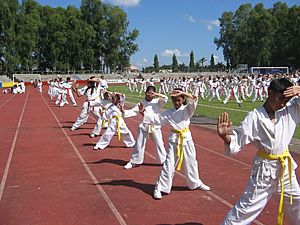
Ireland
In Ireland, students usually have two semesters of 80-minute P.E. classes. This time includes changing and showering. So, the actual activity time is about 60–65 minutes.
Poland
In Poland, students in primary and secondary school must have at least three hours of P.E. each week. Universities also need to offer at least 60 hours of P.E. classes for their students.
Sweden
In Sweden, the amount of P.E. time varies. Generally, younger students (years 0-2) have 55 minutes a week. Middle schoolers (years 3-6) have 110 minutes a week. Older students (years 7-9) have 220 minutes a week. In high school, all students must take a P.E. course that lasts about 90–100 hours over three years. Schools can decide how to spread out these hours.
United Kingdom
In England, students in years 7, 8, and 9 are expected to exercise for two hours a week. Students in years 10 and 11 are expected to do one hour a week. In Wales, students are expected to do two hours of P.E. each week.
North America
Canada
In British Columbia, the government requires students in grade one to be physically active daily, five times a week. Teachers also plan "Daily Physical Activity" (DPA), which is 30 minutes of light to medium activity each day. This is separate from regular P.E. classes. The curriculum also teaches grade one students about healthy living. For example, they learn why exercise is good and how to choose healthy foods.
Ontario, Canada, has a similar rule. Since 2005, elementary schools (grades 1-8) must offer DPA. All students, including those with special needs, must have at least 20 minutes of steady, moderate to strong physical activity each school day.
United States
A 2012 report found that almost 75% of states in the U.S. require P.E. from elementary to high school. However, over half of these states let students do other activities instead of P.E. or don't require a specific amount of P.E. time. Only six states (Illinois, Hawaii, Massachusetts, Mississippi, New York, and Vermont) require P.E. at every grade level. Many states in 2016 did not require a specific amount of P.E. time. More than half allowed students to skip P.E. or do something else. These exceptions can make P.E. programs less effective.
"Zero Hour" is a P.E. class offered before school. It was first started at Naperville Central High School in Illinois. This program is called Learning Readiness P.E. (LRPE). It's based on research showing that fit students are more alert and learn better. This P.E. class includes cardiovascular exercise, core strength training, and movements that use both sides of the body. It also uses reading and math strategies to help students learn and achieve more.
See also
 In Spanish: Educación física para niños
In Spanish: Educación física para niños


